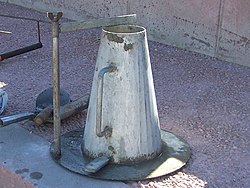Setting attempt
The slump test (engl. Slump test ) is a test for determining the consistency of fresh concrete and is mainly for concretes suitable in the medium consistency range. The process is described in DIN EN 12350-2.
Test execution
The frustoconical metal mold without a bottom of given dimensions is placed on a base plate. The concrete to be tested was placed in three layers of the same thickness. Each layer is compacted with 25 joints. The excess length that is present after it has been introduced is removed flush with a sawing movement. Then the mold is slowly peeled upwards within 2 to 5 seconds without turning or shifting sideways. Immediately after removing the form, the highest height of the collapsed concrete stump is determined. The difference between this height and the height of the form is the "slump". Depending on the size of the slump (10 mm to over 220 mm), the concrete is classified in classes S1 to S5.
| class | Settlement in mm | consistency |
|---|---|---|
| S1 | 10 - 40 | plastic |
| S2 | 50-90 | soft |
| S3 | 100-150 | (very soft |
| S4 | 160-210 | very soft |
| S5 | ≥ 220 | flowable |
Norms and standards
- DIN EN 12350-2 - Testing of fresh concrete - Part 2: Slump




